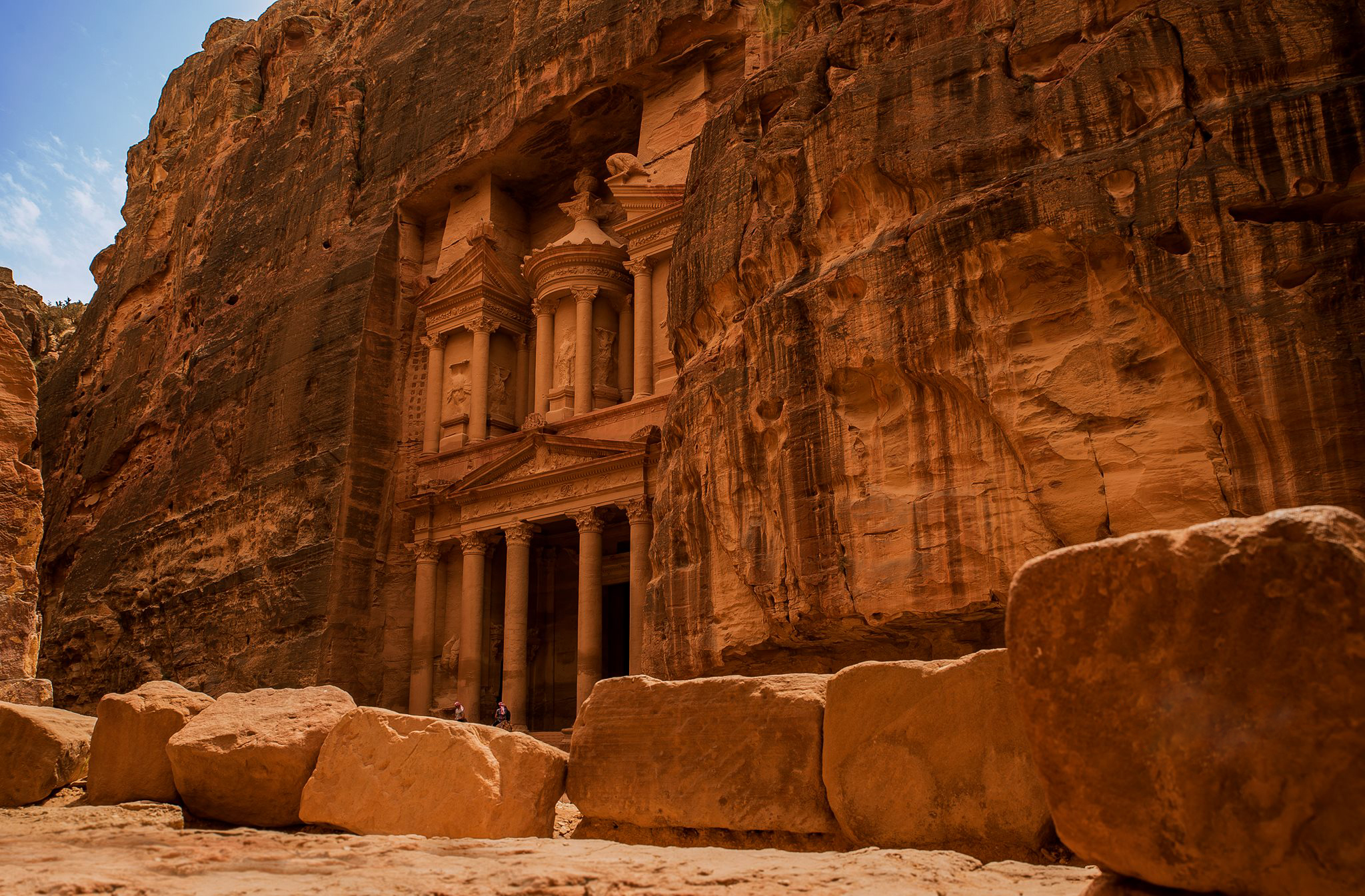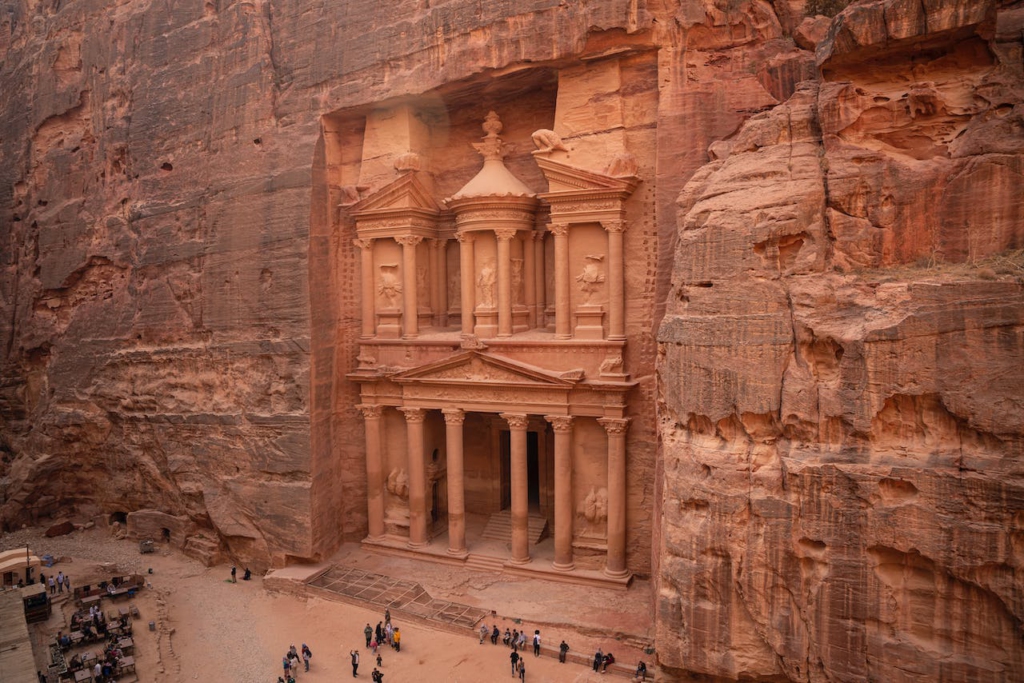
Petra’s Historical Significance
Imagine a city carved into cliffs, hidden in the deserts of Jordan, whispering tales of ancient times. That’s Petra – a place where history and beauty come together in a mesmerizing dance. In this series, we’ll explore the secrets of Jordan’s ancient rose city, where the past feels alive in every stone and carving
Known as the “Rose City” due to the rosy hue of its rock-cut architecture, stands as a testament to the Nabataeans’ architectural prowess. Carved into the rose-red cliffs of southern Jordan over 2,000 years ago, Petra served as a thriving trade hub, linking Arabian, Egyptian, and Syrian civilizations. The city’s strategic location along ancient trade routes contributed to its prosperity, making it a crossroads for diverse cultures and traditions.

Petra’s pièce de résistance is Al-Khazneh, the Treasury, a majestic mausoleum carved into the sandstone cliffs. This iconic structure, with its intricate façade, captures the imagination and curiosity of visitors, whispering tales of ancient civilizations and their architectural marvels. As you wander through the narrow Siq, a natural gorge leading to the heart of Petra, you’ll find a trove of tombs, temples, and theaters, each unveiling a chapter of Petra’s rich history.
What sets Petra apart is not just its historical significance but the sheer beauty of its rose-red rock-cut architecture. The city’s design seamlessly integrates with the natural landscape, creating a harmonious blend of human ingenuity and nature’s grandeur. The intricate carvings and ornate details of Petra’s structures reflect the artistic finesse of the Nabataeans, leaving visitors awe-struck by the city’s mystical charm.
Beyond Petra’s sandstone marvels, Jordan unfolds as a tapestry of cultural and historical richness. From the ancient ruins of Jerash to the serene waters of the Dead Sea, Jordan encapsulates millennia of history within its borders. The warm hospitality of its people, the vibrant markets, and the tantalizing flavors of Jordanian cuisine add layers to the country’s allure, inviting travelers to immerse themselves in an experience that transcends time.
The Rose City
Petra’s story begins with the Nabataeans, an industrious ancient civilization that carved a thriving city out of the rugged desert terrain around the 6th century BCE. The Nabataeans, skilled traders and builders, established Petra as a center for commerce, strategically positioned at the crossroads of major trade routes.
Petra’s location at the intersection of Arabian, Egyptian, and Syrian trade routes made it a bustling hub for the exchange of goods, ideas, and cultures. The city’s prosperity soared as it became a vital link connecting the East and West, contributing to the growth of the Nabataean civilization.
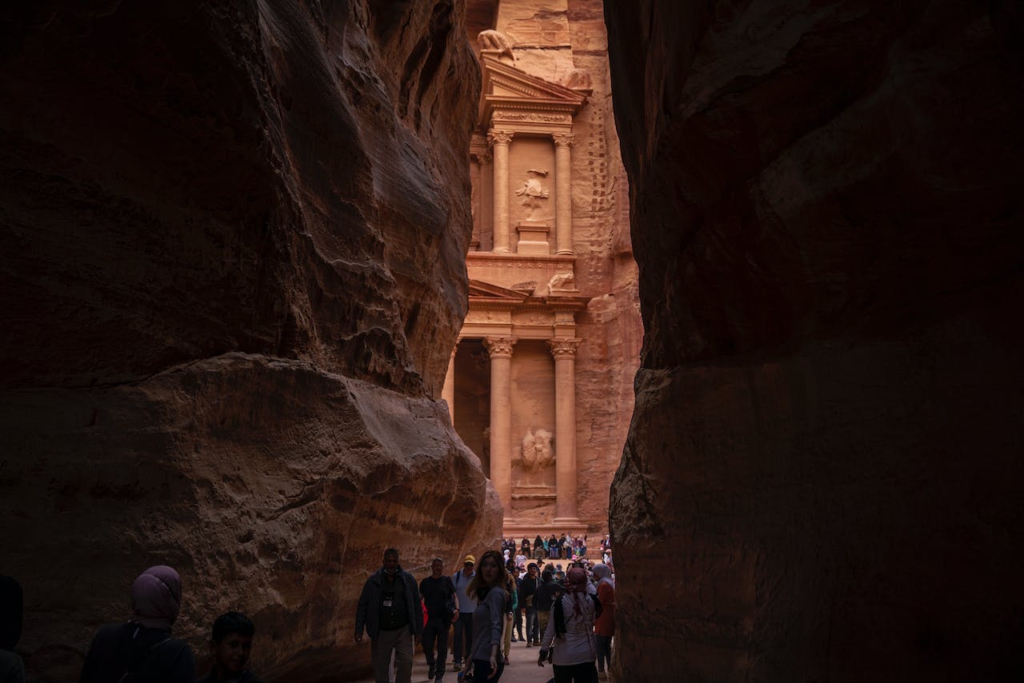
To enter this place is to embark on a captivating journey through the Siq, a narrow, winding gorge that serves as the grand gateway to the ancient city. The towering cliffs on either side, with their hues of rose-red, create a natural passage that builds anticipation, unveiling the wonders of this location one step at a time.
The crown jewel of Petra, Al-Khazneh, greets visitors with a breathtaking facade carved into the sandstone cliffs. This iconic mausoleum, adorned with intricate details and crowned with a towering urn, is a testament to the Nabataeans’ architectural finesse. The interplay of light and shadow on the rose-colored rock adds a mystical touch to this ancient marvel.
Beyond the Treasury, Petra reveals additional architectural wonders, such as the Monastery (Ad-Deir), another monumental structure carved high into the cliffs. The Street of Facades showcases a row of intricate tombs, while the Great Temple and the Royal Tombs highlight the grandeur that defined Nabataean construction.
The mesmerizing rose-colored sandstone, indigenous to the region, played a crucial role in shaping the city’s distinctive character. This reddish-hued rock not only lent the area its nickname, the Rose City, but also served as a canvas for the Nabataeans’ artistic expressions. The color, varying from soft pinks to deep reds, creates a warm and inviting ambiance, enhancing the allure of the architectural wonders in this locale.
Mysteries Engraved in Stone
Among the captivating secrets this place harbors are the Royal Tombs, a collection of majestic burial chambers nestled within the rose-hued cliffs. Carved with precision, these tombs served as final resting places for Nabataean royalty. The intricately adorned facades of the Royal Tombs, including the Urn Tomb and the Corinthian Tomb, stand as a testament to the high regard the Nabataeans held for their rulers.
Delving deeper into the hidden chambers, unveils the mystery surrounding Nabataean burial rituals. The elaborate tombs not only housed the departed but also reflected a cultural reverence for the afterlife. The symbolic carvings and intricate details etched into the rock reveal clues about the spiritual beliefs and funeral practices of this ancient civilization.
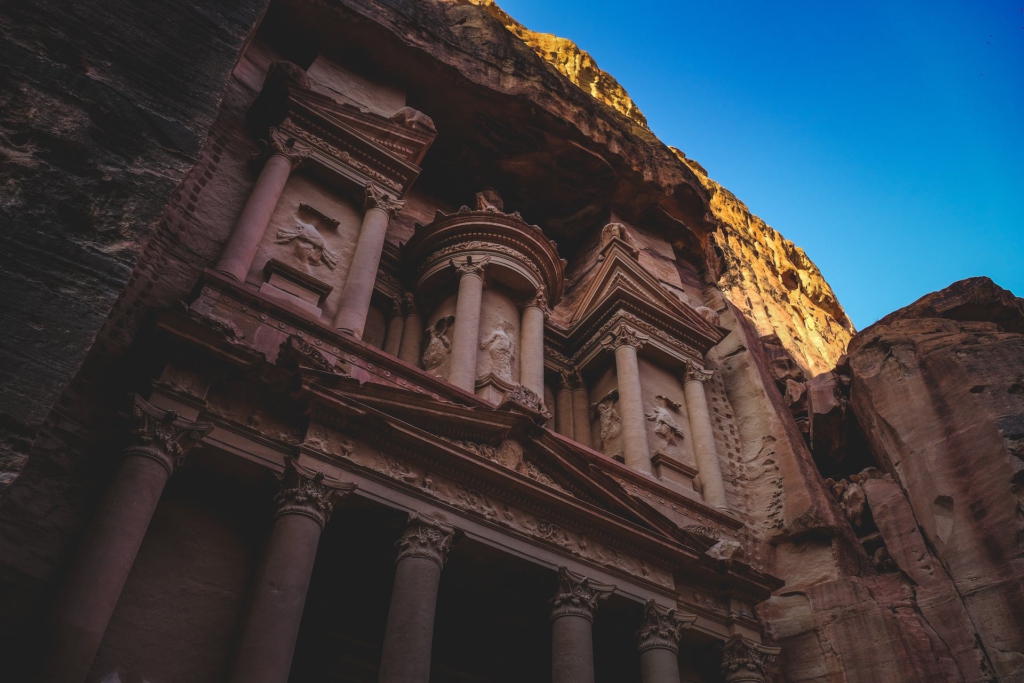
The quest to unravel Petra’s enigmatic past continues through ongoing archaeological excavations and discoveries. Archaeologists have unearthed artifacts, pottery, and ancient texts that shed light on the daily life, trade, and cultural interactions within the city. These findings contribute to a deeper understanding of Petra’s role in the ancient world and the complexity of Nabataean society.
Beyond the tangible relics, researchers are on a quest to decipher the intricacies of Nabataean culture. The Nabataeans left behind no written records, adding an extra layer of challenge to historians and archaeologists. Yet, through a combination of architectural analysis, artistic interpretations, and comparisons with neighboring civilizations, scholars strive to piece together the puzzle of Nabataean life, spirituality, and societal structures.
As the chisels of archaeologists carefully carve away the layers of time, Petra’s mysteries gradually come to light. The hidden tombs and chambers, each with its own story to tell, offer glimpses into a civilization that thrived in the arid landscapes of Jordan. The ongoing research and archaeological endeavors serve as a testament to the enduring allure of Petra, inviting modern explorers to partake in the excitement of uncovering ancient secrets.
Immersing in the Wonders of Petra
To truly savor the magic, timing is key. The best times to visit are during the cooler months of spring and autumn when the weather is more forgiving. The play of sunlight on the rose-red cliffs is particularly enchanting during these seasons, creating a picturesque backdrop for exploration. It’s advisable to avoid the scorching heat of summer and the chilly winter months for a more comfortable and enjoyable visit.
Navigating the labyrinthine wonders of Petra presents visitors with two main options: guided tours and self-exploration. Knowledgeable guides provide historical context, unveiling the stories etched into the city’s stones. For those seeking a more independent adventure, self-guided exploration allows for a personalized journey, discovering hidden corners at your own pace. Whichever path you choose, each turn in Petra promises a new revelation.

Petra stands as a beacon, drawing travelers from across the globe to the heart of Jordan. Its historical significance and architectural marvels have made it a symbol of Jordanian heritage, significantly impacting the country’s tourism. The influx of visitors brings economic opportunities to local communities, fostering a sense of pride and preservation for this cultural treasure.
Beyond the ancient stones, experiencing today involves connecting with the vibrant local community. Jordanians are known for their warm hospitality, and this extends to visitors exploring. Engaging with locals provides insights into contemporary Jordanian life, allowing travelers to appreciate the seamless blend of tradition and modernity. Exploring nearby markets, trying local delicacies, and participating in cultural events offer immersive experiences that complement the historical journey through Petra.
As you step into the timeless realm of Petra, the experience extends beyond the archaeological wonders. It intertwines with the rhythms of modern-day Jordan, creating a rich tapestry of exploration. Whether you choose the guidance of a seasoned storyteller or embark on a solitary adventure, Petra unfolds as a living testament to the enduring allure of the past, harmonizing with the vibrant present of Jordan.
Journeying Rose City
Getting to Petra is an adventure in itself, and various transportation options cater to different preferences. For those arriving by air, Jordan boasts well-connected airports, with Queen Alia International Airport being the primary gateway. From there, a scenic drive to Petra is a popular choice, offering glimpses of Jordan’s diverse landscapes. Additionally, buses and shared taxis provide affordable and accessible alternatives, ensuring travelers can reach Petra conveniently from major cities like Amman.
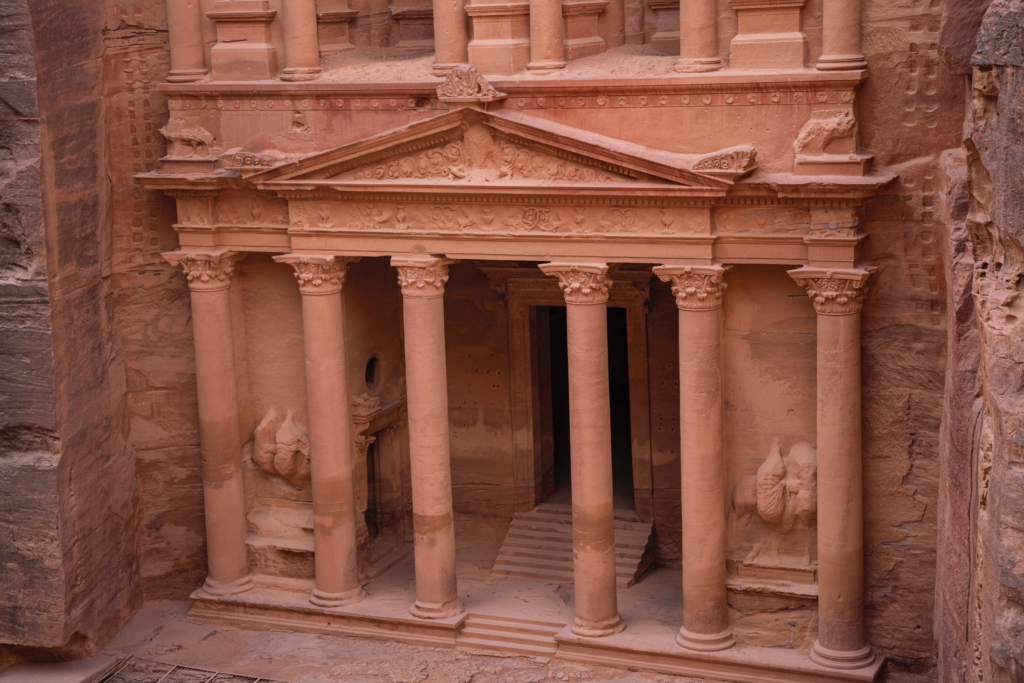
Before immersing yourself in Petra’s wonders, it’s essential to be aware of entry fees and permits. The Jordan Pass, a cost-effective option for tourists, includes entry to Petra along with other attractions. Individual entry fees are also available, and it’s advisable to check current rates and regulations before planning your visit. Remember that certain areas within Petra may require additional tickets, so it’s beneficial to plan accordingly for a seamless exploration experience.
When it comes to accommodation near Petra, a range of options caters to diverse preferences and budgets. From luxurious hotels with stunning views of the rose-red cliffs to cozy guesthouses offering a taste of local hospitality, Petra’s vicinity provides a variety of choices. Many accommodations are conveniently located, allowing visitors to wake up amidst the ancient allure of Petra and embark on their journey without hassle.
Exploring the surroundings can work up an appetite, and the dining experiences in and around the ancient city offer a delightful blend of flavors. Inside Petra, you’ll find quaint cafes offering refreshments, providing a perfect spot to rest and take in the surroundings. Beyond the archaeological site, the nearby town of Wadi Musa boasts a range of restaurants, serving traditional Jordanian cuisine alongside international dishes. From savory falafels to aromatic kebabs, dining near Petra is a culinary adventure that complements the cultural exploration of the region.
As you plan your journey to Petra, these practical considerations ensure a smooth and enjoyable adventure. From choosing the right mode of transportation to savoring local delicacies, each detail contributes to an immersive experience that extends beyond the ancient stones, making your visit to Petra a seamless and memorable exploration of Jordan’s cultural and historical richness.
Importance of Petra’s History and Architecture
In the heart of Jordan, Petra stands as a living testament to the marvels that time, artistry, and history can carve into the fabric of a place. The Nabataeans, with their ingenious civilization, birthed this ancient rose city over 2,000 years ago, etching Petra’s name into the annals of human achievement. The rose-red sandstone cliffs, the majestic facades of the Royal Tombs, and the intricate details of Al-Khazneh are not mere relics but portals to a bygone era, inviting us to unravel the mysteries engraved in stone.

As we’ve uncovered the layers of Petra’s history, from its role as a bustling trading hub to the hidden tombs shrouded in mystery, the call to explore this ancient rose city becomes an irresistible invitation. The Siq whispers tales of the past, and the Monastery perched high in the cliffs beckons the curious traveler. Petra is not merely a destination; it’s an immersive journey through time, where each carved stone has a story to tell. The mysteries concealed within its hidden chambers await those who dare to venture into its embrace.
Jordan, with its cultural richness and historical tapestry, extends an invitation to those seeking a unique travel experience. Petra, as the jewel in Jordan’s crown, serves as a gateway to a country where ancient traditions coexist with the vibrant pulse of modern life. Beyond the archaeological wonders, Jordan offers the warm hospitality of its people, the tantalizing flavors of its cuisine, and landscapes that range from the ancient wonders of Petra to the otherworldly landscapes of Wadi Rum and the therapeutic waters of the Dead Sea.
Embarking on a journey to Jordan means stepping into a realm where the past and present dance in harmony. It’s a chance to walk in the footsteps of ancient civilizations, connect with the local communities, and savor the timeless beauty of Petra. So, let the allure of the rose-red city beckon you, and may your travels in Jordan be an exploration of history, culture, and the enchanting mysteries etched into the very stones of Petra.

